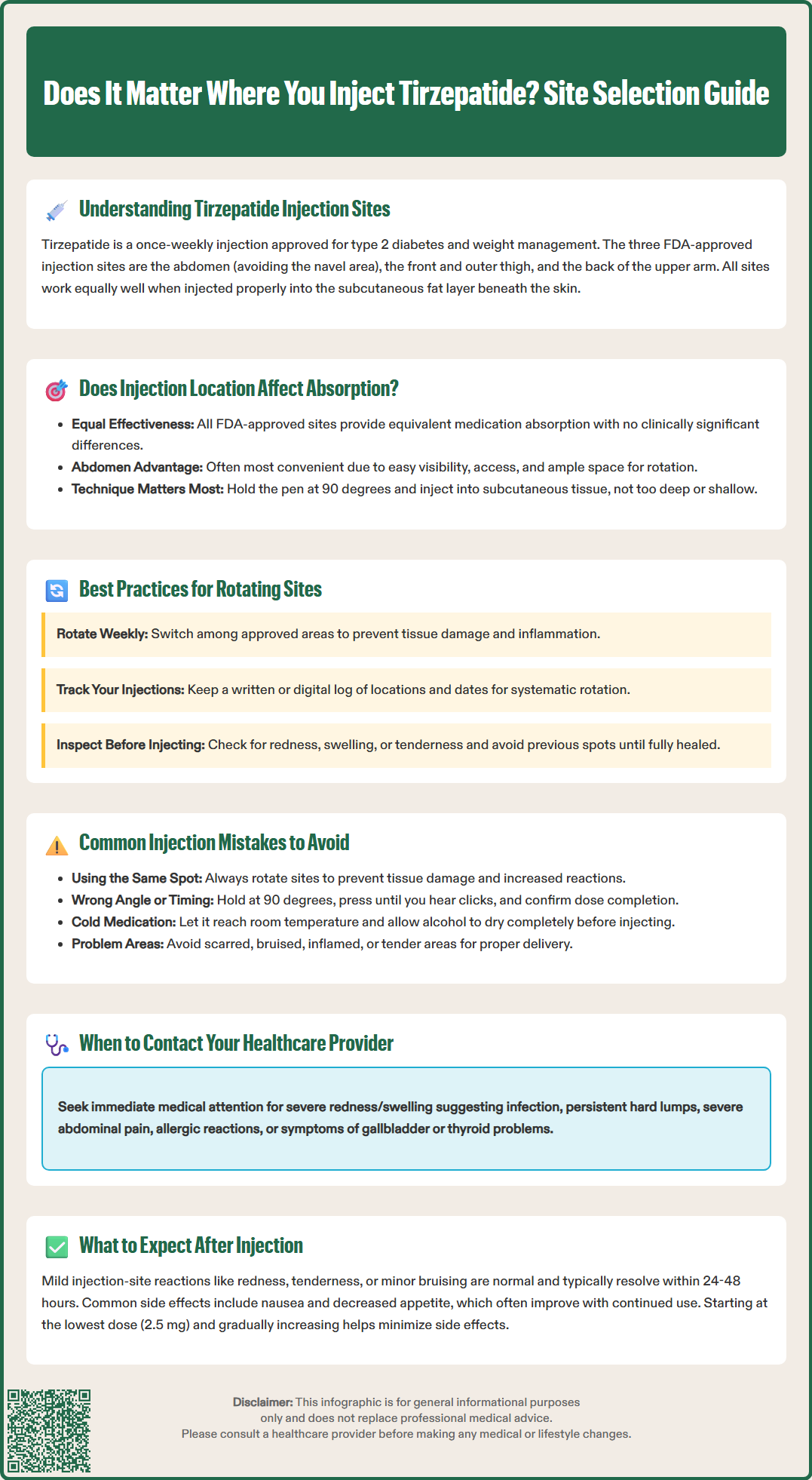LOSE WEIGHT WITH MEDICAL SUPPORT — BUILT FOR MEN
- Your personalised programme is built around medical care, not willpower.
- No generic diets. No guesswork.
- Just science-backed results and expert support.
Find out if you’re eligible

Does it matter where you inject tirzepatide? Yes, but primarily for safety and comfort rather than medication effectiveness. Tirzepatide (Mounjaro, Zepbound) is an FDA-approved once-weekly injection for type 2 diabetes and chronic weight management. The medication can be administered in three approved sites: the abdomen, thigh, or upper arm. While absorption rates remain consistent across these locations when properly injected, choosing the right site and rotating systematically helps prevent tissue damage, reduces discomfort, and ensures optimal subcutaneous delivery. Understanding proper injection technique and site selection is essential for successful long-term therapy with this dual GIP and GLP-1 receptor agonist.
Quick Answer: Injection site matters for tirzepatide primarily for safety and comfort, not efficacy, as all three FDA-approved locations provide equivalent absorption when properly administered.
Tirzepatide (Mounjaro, Zepbound) is a once-weekly subcutaneous injection approved by the FDA for type 2 diabetes management and chronic weight management. The medication is a dual glucose-dependent insulinotropic polypeptide (GIP) and glucagon-like peptide-1 (GLP-1) receptor agonist that works by enhancing glucose-dependent insulin secretion, suppressing glucagon release, and slowing gastric emptying.
The FDA-approved injection sites for tirzepatide include three specific areas: the abdomen, the thigh (front and outer areas), and the upper arm (back of the upper arm, which may require assistance from another person). These sites are chosen because they contain adequate subcutaneous tissue—the layer of fat beneath the skin but above the muscle—which allows for proper medication absorption. When injecting in the abdomen, avoid areas that are tender, bruised, red, hard, scarred, or have stretch marks, and do not inject within the area around the navel.
It does matter where you inject tirzepatide, but primarily for safety and comfort rather than differences in efficacy. Each approved site provides reliable subcutaneous access when injected properly. The key consideration is ensuring the injection reaches the subcutaneous layer rather than into a vein or muscle.
Patients should avoid injecting into areas with skin abnormalities, including active inflammation, infection, rashes, scars, or areas with significant bruising or hardened tissue from previous injections. Understanding these anatomical considerations helps ensure optimal medication delivery and minimizes the risk of injection-site reactions or discomfort.
According to the FDA prescribing information for tirzepatide, there are no clinically relevant differences in absorption or exposure based on injection site when properly administered in the approved locations (abdomen, thigh, or upper arm). Tirzepatide's once-weekly dosing schedule and extended half-life of approximately 5 days help maintain consistent therapeutic levels regardless of injection site.
Many patients find the abdomen convenient for self-administration due to better visibility and access. The abdominal area also provides a large surface area for site rotation, which becomes important for long-term therapy. The thigh offers a practical alternative for patients who prefer not to inject in the abdominal area or who have limited abdominal subcutaneous tissue. Upper arm injections may require assistance from another person but remain an effective option.
What matters more than the specific site is the consistency of injection technique and proper subcutaneous placement. Injecting too deeply or too shallowly can affect absorption and cause discomfort. When using tirzepatide pens, follow the Instructions for Use, which specify holding the pen perpendicular (90 degrees) to the skin surface. This technique helps ensure proper delivery to the subcutaneous tissue regardless of the chosen site.
Patient preference, comfort, and the ability to properly rotate sites should guide the selection of injection locations rather than concerns about differential absorption rates between approved sites.

Systematic rotation of injection sites is important for preventing tissue changes and localized inflammation that can cause discomfort. According to tirzepatide product labeling, you should use a different injection site each week, rotating within or between the approved regions (abdomen, thigh, upper arm).
Effective rotation strategies include:
Using different areas of the abdomen: Rotate through different sections of the abdomen, staying away from the navel and any previous injection sites
Alternating between body regions: Use the abdomen one week, thigh the next week, creating a predictable pattern
Avoiding previous injection sites: Choose a different spot away from your previous injection until the skin returns to normal
Keeping a written or digital log: Track injection locations and dates to ensure systematic rotation, particularly helpful during the initial months of therapy
Patients should inspect potential injection sites before each dose, looking for signs of previous injection reactions, including redness, swelling, hardness, or tenderness. If you notice persistent lumps or skin changes at injection sites, consult your healthcare provider, as these may indicate improper injection technique or the need for site rotation adjustment.
For patients with limited subcutaneous tissue or those who have used injectable medications long-term, working with a diabetes educator or nurse can help identify optimal rotation patterns and ensure proper injection technique. Some patients benefit from visual aids or smartphone apps designed to track injection site rotation.
Several injection errors can compromise tirzepatide effectiveness or increase the risk of adverse effects. Injecting into the same site repeatedly is among the most common mistakes, leading to tissue damage, discomfort, and increased injection-site reactions.
Improper injection technique represents another frequent error. Tirzepatide pens are designed to be held perpendicular (90 degrees) to the skin as specified in the Instructions for Use. Not following the proper sequence—pressing and holding the pen against the skin, waiting for the clicks, and confirming the indicator shows the dose is complete—can result in incomplete dosing.
Failing to allow the medication to reach room temperature before injection may increase discomfort. Check the product Instructions for Use for specific guidance on how long to keep the pen out of refrigeration before use. Additionally, not allowing alcohol to dry completely after skin preparation can cause stinging during injection.
Injecting into areas with poor subcutaneous tissue or into areas with active skin conditions compromises medication delivery and increases infection risk. Some patients mistakenly inject into areas with significant scarring from previous surgeries or areas that are tender, bruised, or inflamed.
Improper disposal of used pens poses serious safety risks. Each tirzepatide pen is designed for single use only. After injection, the pen should be disposed of in an FDA-cleared sharps container. The medication should never be transferred to another device. If you experience persistent injection-site reactions, significant bruising, or concerns about proper technique, contact your healthcare provider or request a consultation with a certified diabetes educator.
Most patients experience minimal discomfort following proper tirzepatide injection, though mild injection-site reactions are common and generally resolve within 24-48 hours. Expected local reactions include slight redness, mild tenderness, and occasional minor bruising at the injection site. These reactions are normal inflammatory responses and do not indicate allergy or improper administration.
Some patients notice a small raised area or bump immediately after injection, which represents the medication volume in the subcutaneous space. This typically dissipates within several hours as the medication disperses and absorbs. Applying gentle pressure (without rubbing) with a clean gauze pad immediately after injection can minimize bruising risk.
Systemic effects unrelated to injection location may occur as tirzepatide begins working. The most common adverse effects include nausea, decreased appetite, and occasional gastrointestinal discomfort. These effects typically peak during the first few days after injection and often diminish with continued therapy. Starting with the lowest dose (2.5 mg) and gradually titrating upward helps minimize these effects. The risk of hypoglycemia (low blood sugar) increases when tirzepatide is used with insulin or sulfonylureas.
Warning signs requiring medical attention include:
Severe or expanding redness, warmth, or swelling at the injection site suggesting infection
Persistent hard lumps that don't resolve
Severe abdominal pain or persistent vomiting that may indicate pancreatitis (rare but serious)
Signs of allergic reaction including widespread rash, difficulty breathing, or facial swelling
Symptoms of gallbladder problems (pain in your upper stomach, fever, yellowing of skin or eyes)
Symptoms of thyroid tumors (lump or swelling in your neck, hoarseness, trouble swallowing, shortness of breath)
Patients should maintain their regular injection schedule regardless of minor injection-site reactions. However, if a particular site consistently causes significant discomfort or reactions, discuss alternative sites with your healthcare provider. Keeping the injection site clean and dry for several hours post-injection can help minimize local reactions. Most patients find that injection-site tolerance improves significantly after the first few doses as proper technique becomes routine.
No, you should rotate injection sites each week to prevent tissue damage, lipohypertrophy, and increased injection-site reactions. Use different areas within the abdomen, thigh, or upper arm, avoiding previous injection sites until the skin returns to normal.
No, the abdomen and thigh provide equivalent absorption and effectiveness when tirzepatide is properly injected. Choose based on personal comfort, accessibility, and the ability to rotate sites systematically over time.
Injecting outside approved sites or into areas with poor subcutaneous tissue, active skin conditions, or scar tissue may compromise medication delivery and increase infection risk. Always use FDA-approved sites: abdomen, thigh, or upper arm, and consult your healthcare provider if you have concerns about proper technique.
All medical content on this blog is created using reputable, evidence-based sources and is regularly reviewed for accuracy and relevance. While we strive to keep our content current with the latest research and clinical guidelines, it is intended for general informational purposes only.
This content is not a substitute for professional medical advice, diagnosis, or treatment. Always consult a licensed healthcare provider with any medical questions or concerns. Use of this information is at your own risk, and we are not liable for any outcomes resulting from its use.